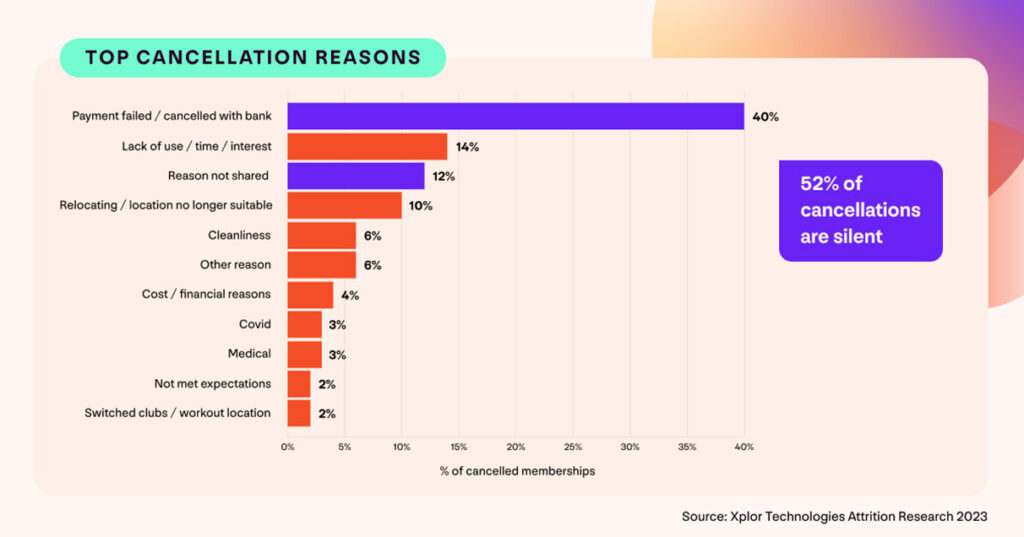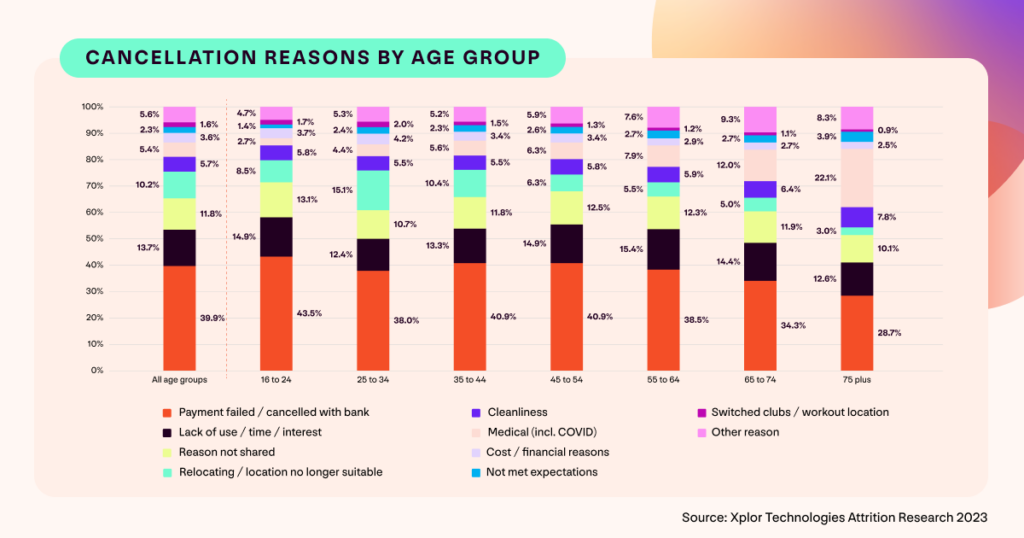‘Why do my members quit the gym?’ This is a common question for gym owners and operators. And the answer is often unclear. Get the lowdown on why members quit and how to reduce cancellations.
Ever feel tempted to ignore retention and just focus on signing up new members? You wouldn’t be alone!
For many owners and operators, it feels easier to focus on acquiring new members. Yet, if you are serious about growing your business you need to focus on retention too.
And that means understanding why members quit the gym – and why they quit YOUR gym.
We’re here to help.
Why do attrition & retention matter?
Attrition and retention are often used interchangeably. So, before diving into why they matter, it’s important to know the difference:
- What is attrition? Attrition is a measure of how many people leave in a given week, month, quarter, or year
- What is retention? Retention is a measure of months that helps you to track growth. It lets you see how long members stick with you for
Attrition and retention are intrinsically linked. Reduce the number of members leaving (attrition). And you’ll increase the length of time members stay with you (retention).
So, why do they matter? Firstly, signing up new members can be costly. Anywhere from 5 to 25 times more costly than retaining existing ones. If you’re not paying attention to attrition and retention, you’ll be paying out to get new members.
Secondly, you’ll be missing out on the opportunity to increase profits. Research has shown that upping retention rates by 5% can increase profits by 25% to 95%.
Reducing attrition will increase member life time value (LTV). Plus, you’ll cut the need to spend time and money replacing members who quit the gym. So, your business will save money and grow profitability. A win-win!
Why do gym members cancel?
Looking at Xplor data from over 300,000 UK gym members who cancelled between January 2017 and April 2023*, we discovered why members leave.
The biggest reason why members quit the gym is due to a payment failing. Usually because of insufficient funds in the member’s account. Or the member cancelling the payment with the bank.

Most former gym members have their membership cancelled. They don’t cancel it themselves and don’t tell their club why they are leaving.
5 biggest reasons why members quit the gym
Let’s look at the top reasons why members cancel their gym membership in more detail.
1. Payment failed or cancelled with bank
Our Winning The War On Attrition research found that, in the UK, 40% of former members quit the gym as their membership was cancelled due to a payments issue. The most common cause of a payment failure is insufficient funds in a bank account.
Beyond this, failures can happen when a bank account is closed without transferring the membership Direct Debit to a new account. Likewise, payments are often rejected as a member has cancelled their Direct Debit with their bank.
Cancellations like this are not helpful. You don’t get the chance to find out why these members quit. Read on for practical ways to avoid these silent cancellations as members quietly quit.
2. Lack of use, time, or motivation
14% of former members cancelled as they weren’t using their membership enough, lacked time to visit, or lost motivation to go.
It’s easily done. If new members fail to get into the habit of using their membership, they become at risk of cancelling. Likewise, if a member becomes bored of their workout routine and loses the motivation to visit, they become high-risk.
How can you avoid these cancellations? Start with onboarding. A robust gym member onboarding process will help get members of all experience levels into the habit of visiting you regularly. And will cheer them on to make that next visit when they most need encouragement.
Your gym management software should make it easy to identify members at-risk of cancelling. So, you can make sure you are re-engaging high-risk gym members before they quit.

3. Reason not shared
12% of former members cancelled without sharing a reason. These members cancelled directly with their club. Yet, like those with a payment failure, the cancellation was silent with no reason shared. That means 52% of former members cancelled silently.
The good news is that these members cancelled directly. Want to encourage more members to tell you why they are cancelling? You need to create a culture that welcomes feedback.
Seek gym member feedback at every possible touchpoint. And take positive action to address concerns or issues. Soon, you’ll find more members are willing to tell you why they are cancelling.
4. Relocating and/or location no longer suitable
This was the fourth biggest reason for cancelling according to our attrition research. 10% of former members cancelled due to the location of a club no longer being suitable. This is typically due to moving house or changing jobs/work locations.
Former members aged 25 to 34 are most likely to quit the gym due to the location no longer being suitable. Research has found that Brits move the most between the ages of 18 to 30. So, coupled with changing jobs more frequently than older age groups, it makes sense that this age group would cancel a membership for this reason.
This is also a popular cancellation reason for gymgoers in London clubs. 27% of former members of London clubs cancelled for this reason. London is a transient city with many people staying only a short time to study or work before relocating.
Cancellations for this reason are often tough to avoid.
Do you have many locations? Then you may be able to make it easy for members to switch to a club that’s conveniently located. If that’s not an option, make leaving a positive experience. So, the door will be open for a future return if circumstances change.
5. Cleanliness
6% of former members cancelled due to concerns with cleanliness. Even during 2020 and 2021, this percentage remained steady. Clubs put a lot of effort into keeping facilities clean for members. That so few members quit for this reason is testament to the hard work you and your team put in.
If you are regularly seeking honest feedback from your members, you’ll be able to see when you’re not meeting cleanliness expectations. And resolve issues before members leave. Publicise improvements you are making. So, to encourage any members who may have stopped visiting to come back in.
How to reduce silent cancellations
According to the Winning The War On Attrition research, 52% of members who cancelled their membership did so silently.
These quiet quitters either ended up with a cancelled membership due to a payment failure (40%) or cancelled without sharing why (12%).
Cancellation reasons help you make improvements. If most members aren’t even cancelling with you, there’s no chance to get valuable feedback. Feedback you can use to prevent future members leaving for the same reasons.
Follow these top tips to reduce silent cancellations:
Tip #1: Build a feedback culture & use exit survey best practices
Members need to feel safe to feedback and share dissatisfaction. They need to feel that you’ll listen and act on what you hear (without necessarily trying to win them back).
The most effective way to encourage member honesty, even in tough situations, is to build a feedback culture. One where members feel a deep connection to your club and that they are always heard. (Read more about building a culture that gives you plenty of actionable feedback).
A starting point is to build an effective exit survey. Use this as well as recording a leaving reason within your gym management software. Add a link to the survey in your cancellation confirmation email. And let cancelling members know to expect it, encouraging them to complete it.
Follow these best practices for an exit survey that gives you valuable insights.
Do:
- Use open questions – you’re looking for detail with this survey
- Ask if there’s anything else you should know – people can use this as an opportunity to share the real reason they’re leaving
- Explain how you use the feedback you get (include proof if you can)
- Ask members if you can get in touch for further info
Don’t:
- Ask closed questions that aren’t specific or contain two questions in one (e.g., ‘Tick if you are unhappy with the service or facilities’)
- Make the survey too long
- Use language that’s negative (e.g., ‘we hate to see you leave’)
Tip #2: Give members more control
As well as creating a feedback culture, give members more flexibility and control over their membership to prevent silent cancellations. And even stop some cancellations from happening.
Offer freezes
Letting members freeze for a while is a great alternative to cancelling if a member can’t visit for a specific period. So, ideal if a member is travelling, busy with family or work commitments, or experiencing injury or illness.
Make sure you get the member back in when the freeze is up. Consider offering an incentive or reason to make that return visit.
“Make sure you limit the amount of time a freeze lasts for. And communicate consistently during a freeze to encourage an early return and maintain engagement. This is critical to get members back after a freeze and avoid cancellations.”
~ Guy Griffiths, GGFit
Create a positive experience
Also, think about how you can make cancelling simple. That might sound counterproductive. Yet, ending on a good note means members are more likely to re-join. And it can encourage an honest leaving reason.
“We often say that first impressions count. Yet, each touch point of a member journey should be meaningful. And it’s essential that if this moment is the last interaction with the club that it’s approached positively and leaves a lasting impression.”
~Julie Allen, Active Insight
Give members the option to cancel their membership online, making any terms clear.
This is especially important for certain groups of members. 65% of Millennials (born 1981-1996) and Gen Z (born 1997-2012) prefer to communicate digitally, rather than in-person.
And 52% of Millennials and 44% of Gen Z have confidence in following non-company guidance when it comes to seeking customer service.
They don’t want to pick up the phone or visit in-person to cancel. So, many cancel indirectly – 43.5% of former members aged 16-24.

Make the path to cancellation clear. And give a digital option to encourage members to cancel with you. In your online self-service area, let members cancel. And as a part of that process capture a leaving reason.
By doing this you’ll give members a non-confrontational way to share this information. Set up an automated confirmation email to go out afterwards. Include a link to your exit survey. And explain why completing this is important.
Tip #3. Choose the right payment processes
The most common cause of membership cancellations is a payment failing. Typically, the payment has been cancelled directly with the bank. Or the member didn’t have enough money in their account to cover the payment.
That means 40% of members cancel indirectly and never tell you why.
As well as making it simpler for members to cancel or freeze directly with you digitally, the right approach to managing membership payments will reduce silent cancellations.
Follow these best practices to avoid payment failures:
Verify all new Direct Debit mandates
Do this automatically before the first collection to check the bank details are correct. For incorrect details, send an automated follow up email and SMS. This should make it easy for new members to correct their bank details without creating extra work for your team.
Accept new bank details
Let members change their bank details via your online self-service area. Make it clear when the new details will be used from.
Automated, proven approach to failures
Where a payment is rejected, use an automated follow up approach. And let the member know what’s happening (explain how to resolve the issue and/or get in touch).
Win the war on attrition
Ready to cut attrition, grow retention, and unlock lasting growth? Get your free copy of Winning The War On Attrition.
The report is packed full of insights and tactical takeaways to help you conquer the battle for member engagement and motivation. So, you keep more members coming back for longer.

The wrap up…
Most members quit the gym without telling clubs why. This creates an attrition challenge for you as a gym owner or operator. Without feedback on why members leave, you can’t make improvements to prevent more from leaving for the same reason in the future.
How can you address the challenge that these quiet quitters pose? Create a culture where feedback is the norm. Give members more control over their membership. And choose the right payment processes to avoid failures.
Get more insights to help you tackle attrition. Claim your free copy of the Winning The War On Attrition report.
* About the research:
The attrition insights featured in this article and the Winning The War On Attrition report are based on Xplor data from 714,674 gym, health club and leisure members paying by Direct Debit in the UK & Ireland.
As well as current members, it includes data on members who held a membership that’s been cancelled between January 2017 and April 2023.
The data was collected in May 2023.

by Xplor Gym
-
First published: 04 September 2023
Written by: Xplor Gym
